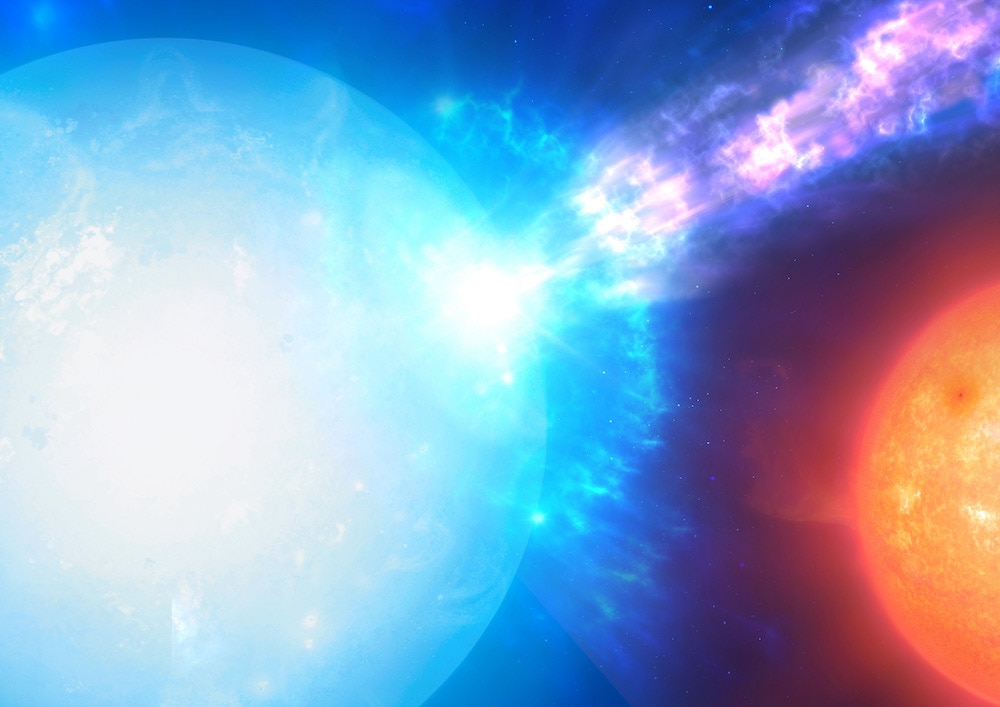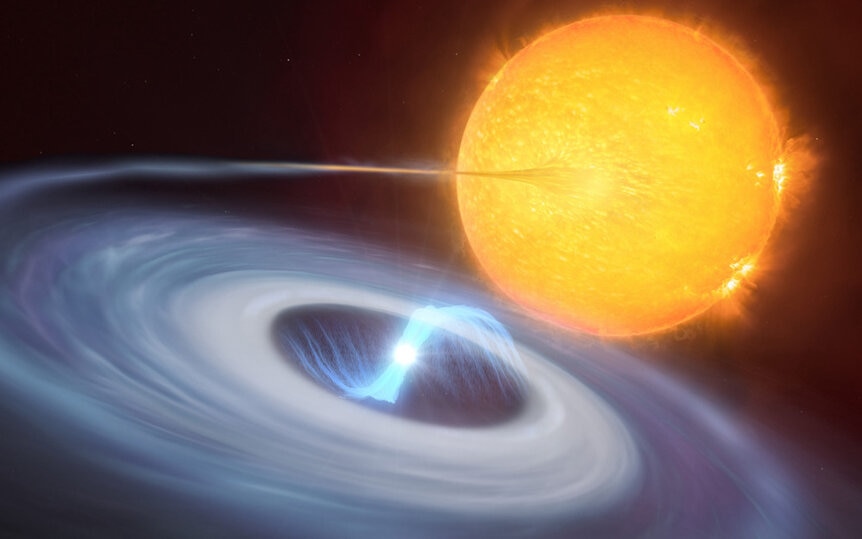Create a free profile to get unlimited access to exclusive videos, sweepstakes, and more!
Introducing the micronova: It’s not a big bang, but not exactly a small one either
Tiny stars erupt in small explosions that are still terrifying on a human scale.

Sometimes, stars explode.
Good thing, too. Heavy elements like iron and calcium are scattered into the Universe by exploding stars, and we owe our very lives to that fact. Your blood and bones and pretty much everything else exist because of it.
There are a lot of different kinds of explosions, though. Novae, kilonovae, supernovae… but now a new one has been discovered, which astronomers have dubbed a micronova. Don’t let the name fool you, though. On a human scale this is still a brain-vaporizingly immense event, because when it comes to astronomy, “small” is a very, very relative term.
Astronomers have seen novae for centuries — the explosion is so bright that suddenly a new star appears in the sky, which was originally called nova stella for, you guessed it, “new star.” The term is ironic, because the star itself is old.
When a star like the Sun dies after billions of years of existence, it blows off its outer layers and reveals its core to space. This object, now called a white dwarf, is small, about the size of Earth, but can have a significant fraction of the Sun’s mass in it, or more if the original star was bigger. The surface gravity of a white dwarf can be over a hundred thousand times the gravity of Earth, which turns out to be critical.
If it’s in a binary system, orbiting another normal star, material — usually almost entirely hydrogen — from that star can be siphoned off by the white dwarf’s immense gravity in a process called accretion. It falls onto the surface and piles up. But the gravity is so strong that, once the hydrogen piles up, it gets compressed enough to undergo thermonuclear fusion, converting the hydrogen into helium and releasing a colossal amount of energy, tens or even hundreds of thousands of times the Sun’s luminosity.
The eruption is brief, material is blasted away into space, and the white dwarf settles down again. Sometimes the pattern repeats, and we get a recurrent nova. Sometimes the hydrogen falls onto the star at just the right rate that it really piles up, and when it suddenly fuses, enough energy is released to tear the star completely apart. For a few weeks this supernova can outshine all the other stars in a galaxy combined, billion of times brighter than the Sun.
That’s at the very top end of the nova scale. And now, it turns out there’s a beastie at the lower end, too. Weirdly, it was discovered by an observatory designed to find exoplanets.
The Transiting Exoplanet Survey Satellite, or TESS, scans the entire sky, sector by sector, making careful measurements of the brightness of hundreds of thousands of stars. It’s looking for the mini-eclipses caused by a planet passing in front of its host star, a method so successful it’s been used to find the vast majority of all exoplanets known.
But it’s not picky, monitoring all the stars in its sight, including white dwarfs. Importantly, it takes measurements over and over at a relatively rapid cadence, so it’s naturally able to spot changes in brightness that might occur on short timescales.
Looking at TESS data, a team of astronomers saw that three white dwarfs underwent bursts of rapid brightening [link to paper]. These three — TV Columbae, ASASSN-19bh, and EI Ursae Majoris — are all binaries, and all are accreting material from their stellar companions. However, instead of normal novae, these bursts were extremely fast, peaking in about an hour and taking around 10 hours to fade.
The energy released was much smaller than a typical nova, too, about a millionth as much, so the astronomers call them micronovae. But what causes them?
Magnetic confinement! White dwarfs, among their other superpowers, can have fierce magnetic fields. Material flowing from the other star is so hot it’s ionized; the atoms have lost one or more electrons. When that happens they can be affected by magnetic fields. Like on Earth, a white dwarf’s magnetic field is shaped something like a doughnut, coming out at one pole and going back in at the other. That ionized material coming from the other star follows that field to the white dwarf’s poles.
In the case of a regular nova, the material can spread out all over the tiny but mighty star’s surface, and when it explodes it’s a global event. But if the magnetic fields are just the right configuration they can act like a force field, confining the hydrogen to just the poles. When enough piles up the runaway, thermonuclear fusion event is triggered, but the amount of material is far less than in a regular nova. BOOM. Or, boom. Micronova.
These have been hypothesized for some time, but the TESS observations of the three white dwarfs make for pretty strong evidence that this is what’s going on [link to paper]. Also, unlike regular novae which take years to build up material, micronovae don’t take as long to refuel, and can take months or mere days to blow up again.
The total bang is still pretty strong, releasing as much energy in a few hours as the Sun does in a couple of weeks. Mind you, the Sun’s luminosity is equivalent to exploding 100 billion one-megaton bombs every second, so it’s a decently substantial explosion. The average amount of hydrogen fused in the event is about 40 quadrillion tons, which is difficult to grasp. That’s equal to a couple of hundred thousand times the mass of Mount Everest, an analogy which I’m not sure really helps.
Mind you, the reason these were seen at all is because we are now looking at the sky in new ways, observing objects all the time, sometimes pretty frequently. We also have big observatories scanning the sky less rapidly but much deeper, seeing fainter objects as well. Because of these innovations we can find objects that eluded us before, events we simply couldn’t see.
There aren’t many truisms in astronomy, but one thing any astronomer will tell you is that when we look at the sky in new ways we see new things. And that means we learn more.
And that’s the whole point.




























